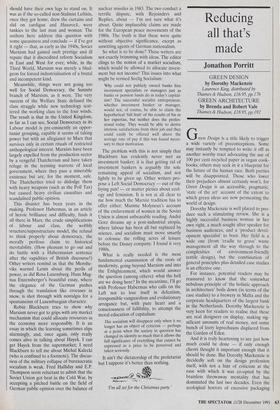Reducing all that's made
Jonathon Porritt
Green Design is a title likely to trigger a wide variety of preconceptions. Some may instantly be tempted to write it off as another worthy tract advocating the use of 100 per cent recycled paper in vegan cook- books; others may seek in it a blueprint for the future of the human race. Both parties will be disappointed. Those who lower their prejudices almost certainly won't, for Green Design is an accessible, pragmatic, `state of the art' account of the extent to which green ideas are now permeating the world of design.
Dorothy Mackenzie is well placed to pro- duce such a stimulating review. She is a highly successful business woman in her own right, a much sought after speaker for business audiences, and a 'product devel- opment specialist' to boot. Her field is a wide one (from 'cradle to grave' waste management all the way through to the complexities of environment-friendly textile design), but the combination of general principles plus detailed case studies is an effective one.
For instance, potential readers may be reassured to know that the somewhat nebulous principle of 'the holistic approach in architecture' boils down (in terms of the case studies) to a brewery in Malta and the corporate headquarters of the largest bank in the Netherlands. Dorothy Mackenzie is very keen for readers to realise that these are real designers on display, making sig- nificant amounts of real money, not some bunch of leery leprechauns displaced from the Garden of Eden.
And it is truly heartening to see just how much could be done — if only enough clients thought it important enough that it should be done. But Dorothy Mackenzie is decidedly soft on the design profession itself, with not a hint of criticism at the ease with which it was co-opted by the brainless throwaway mentality that has dominated the last two decades. Even the ecological horrors of excessive packaging are treated like the peccadilloes of way- wardly creative spirits.
This is probably well judged by the author; a lot of green evangelists remain convinced, despite copious evidence to the contrary, that the best way of converting disbelievers is to stick them with the bill for every environmental problem under the sun. No one will feel preached at in this book, not least because it declines to explore the phenomenon of contemporary consumerism in all its inherent unsustain- ability.
There's a much harder edge to be found in Green Architecture. Brenda and Robert Vale are far less tolerant of the fact that in most architectural practices, even now, genuinely green practices and values remain a rarity. Shoddy, short-life buildings have done untold harm to the social and environmental fabric of all industrialised countries, but the architects' response has often been to blame it all on 'the client', be they cash-strapped local authorities or money-grubbing private developers. Given the potential for huge environmental improvements in all new buildings, such assiduous washing of hands just won't wash any more.
The dozens of examples of 'best green practice' highlighted in this book should acquaint even the most sceptical architect or planner with that potential. It's a very well-designed book, with both drawings and black-and-white and colour photographs giving it a strong visual feel. Six basic principles for green architecture are proposed (including the ever-present 'holistic approach), and each explored within the context of a hard-headed analysis of the state of the Earth today.
But the text never spills over into gratuitous agit-prop. For every problem, there's a solution round the corner. Whether they will work or not is something on which readers may reserve judgment; it would have been good to hear more of the voices of the actual users or owners of the buildings covered, just to be reassured that they really weren't getting frostbite as a result of increased energy efficiency or that what sound like impossibly complex control systems can actually be handled by technophobic knuckleheads such as myself.
In every other respect, the lay person is treated gently, for this is one of those rare books that I suspect will work both for the specialist and for those who are simply interested in architecture and the environ- ment. Its concluding chapter on some new ground rules for the green city is a particularly useful contribution to today's long overdue debate about rescuing cities from their worst ecological excesses. For it's in the cities, where the green rhythms of the natural world are sub- ordinated to the buzz of the concrete jungle, that green design and green architecture will really have to prove their worth.











































































































 Previous page
Previous page